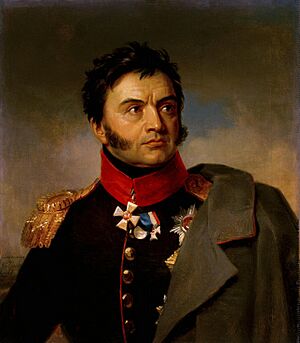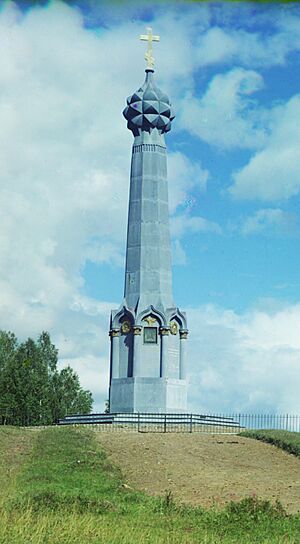Nikolay Raevsky facts for kids
Nikolay Nikolayevich Raevsky (Николай Николаевич Раевский; September 25, 1771 — September 28, 1829) was a famous Russian general. He became well-known for his brave actions during the Napoleonic Wars. His family also had a big impact on Russian society and culture.
Contents
Early Life and Military Start
Nikolay Raevsky was born in Saint Petersburg, a major city in Russia. His family, the Rayevskys, were nobles. They had a long history, possibly even from Scandinavia and Poland. One of Peter the Great's great-grandmothers was from the Raevsky family. Nikolay's grandfather, Semyon Raevsky, worked for the Holy Synod, which was an important church council.
The family became even more important when Nikolay's father, Colonel Nikolay Semyonovich Raevsky, married Ekaterina Samoylova. Ekaterina was a close friend and helper to Empress Catherine II. She was also the niece of Prince Potemkin, a very powerful person at the time.
Sadly, Nikolay's father was killed in a war before Nikolay was born. After his father's death, Empress Catherine helped Nikolay's mother marry a kind and wealthy man named Lev Davydov. He became a good stepfather to Nikolay.
Nikolay started his military training very young. He joined the Semyonovsky Regiment. By the age of 18, he was a premier-major in the Nizhegorodsky Dragoon Regiment. He fought in the Russo-Turkish War, 1787–1792 and showed great bravery. He was even promoted to lieutenant colonel.
Later, he fought in the Polish–Russian War of 1792. For his courage, he received the Order of St. George, a special award, and a gold sword. He also took part in the Russo-Persian War of 1796, helping to capture the city of Derbent.
When Emperor Paul I became ruler, he didn't like Prince Potemkin. Because Raevsky was related to Potemkin, he was removed from the army. But after Paul I died and Alexander I became emperor, Raevsky rejoined the army. He was promoted to Major General.
Fighting in the Napoleonic Wars
Raevsky returned to battle in 1807 during the Napoleonic Wars. He fought alongside Prince Pyotr Bagration in the front lines of the Russian army. He showed great courage in many battles and received another award, the Order of St. Vladimir. Even after being wounded in the Battle of Heilsberg, he continued to lead his troops in the Battle of Friedland.
After a peace treaty was signed, Raevsky fought in the Finnish War. He was part of every major fight and was promoted to lieutenant-general. He also helped capture the city of Silistra during the Russo-Turkish War, 1806–12.
During Napoleon's Invasion of Russia in 1812, Raevsky led the 7th Infantry Corps. His job was to slow down the French army's advance towards Moscow. After the Battle of Saltanovka, he moved his troops to Smolensk. There, he bravely defended the city in the battle for Smolensk.
In the famous Battle of Borodino, Raevsky protected an important part of the Russian army's defenses, which became known as the Raevsky Redoubt. For this, he received another Order of St. George. He then helped chase Napoleon's army out of Russia, fighting in battles like Battle of Maloyaroslavets and Battle of Krasnoi.
Raevsky continued to fight in other major battles across Europe. He was seriously injured near Wachau but kept fighting. For his bravery, he was promoted to Full General in October 1813. He also received a special Austrian award. Due to his injuries, he had to return to Russia for a while.
Once he recovered, Raevsky rejoined the army at the battle of Leipzig. He later took command of an army and led them during the capture of Paris in 1814. After Napoleon was defeated, General Raevsky had the honor of entering Paris alongside Emperor Alexander I.
Later Life and Family
In 1794, Raevsky married Sofia Alexandrovna Konstantinova. She was the granddaughter of a famous scientist, Mikhail Lomonosov. Sofia brought a large estate with her, which included many workers. Nikolay and Sofia had six children: two sons and four daughters.
After the wars, Raevsky settled with his family at Boltyshka, a large estate in Ukraine. This land was very fertile and had many workers.
In 1821, Raevsky became friends with a young poet named Alexander Pushkin. Pushkin became close with Raevsky's sons and sons-in-law. Some of them were part of a group called the Southern Society, which planned a revolt in 1825. Raevsky's eldest son, Alexander, even inspired a character in one of Pushkin's poems.
Raevsky's favorite daughter, Maria, married Prince Sergey Volkonsky. He was a wealthy and open-minded aristocrat who had fought with General Raevsky. His eldest daughter, Ekaterina, married General Mikhail Fyodorovich Orlov.
By 1825, Raevsky no longer believed in the idea of big changes for Russia. He thought Russia should remain a monarchy. Both of his sons and his son-in-law, Mikhail Orlov, left the Southern Society before the revolt happened. However, his half-brother, Vasily Davydov, and Prince Volkonsky stayed in the group.
After the Decembrist Revolt in December 1825, Vasily Davydov and Prince Volkonsky were arrested. They were sent to Siberia for hard labor and exile. Maria, Raevsky's daughter, bravely decided to go with her husband to Siberia, even though her father didn't want her to. She convinced the Emperor to let her go. The Volkonskys lived in Siberia for over thirty years. They were finally allowed to return after a new emperor, Alexander II, pardoned them. Maria's courage inspired a famous poem called "Russian Women."
General Raevsky died at his estate, Boltyshka, four years after the revolt. He was very sad and sick. He died of pneumonia, which he caught while traveling to ask the Emperor to be kind to his daughter. It is said that as he was dying, he looked at a picture of Maria and whispered, "That is the most remarkable woman I have ever known in my life."
Remembering Nikolay Raevsky
Since 2014, a tugboat has been named "General Rayevsky" to honor this brave hero of the 1812 war. This helps keep his memory alive.
In December 2022, a street in Kyiv, Ukraine, that was named after Nikolay Raevsky was renamed to Pavlo Zahrebelnyi street.




